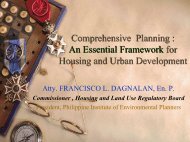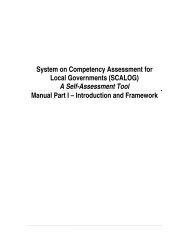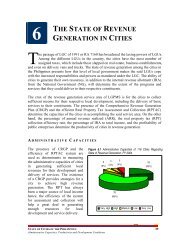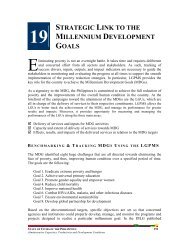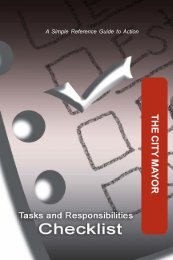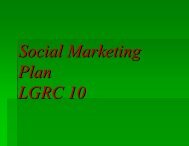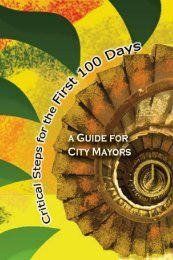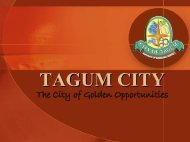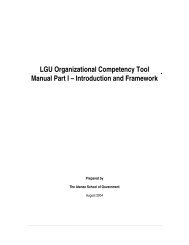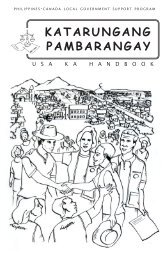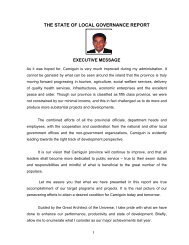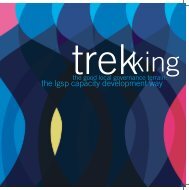Linamon 2004 - LGRC DILG 10
Linamon 2004 - LGRC DILG 10
Linamon 2004 - LGRC DILG 10
- No tags were found...
Create successful ePaper yourself
Turn your PDF publications into a flip-book with our unique Google optimized e-Paper software.
LINAMON, LANAO DEL NORTE“TURNING GARBAGE INTO GOLD”The Basura Atras <strong>Linamon</strong>Abante sa Kalamboan(BALAK) Program
CONTENTSSummaryAbout <strong>Linamon</strong>, Lanao Del Norte’s Balak- “Basura Atras <strong>Linamon</strong>Abante Sa Kalamboan”Project HistoryProject DescriptionProject ResultsB. Replicating BalakKey Implementation StepsReference Matrix On Replicating BalakLessons And Insights In Replicating The ProjectAnnexes1336788111213
Summarynot my problem, it’s the government’s!” Such was the prevailing sentimentof residents of <strong>Linamon</strong>, a 5th class municipality in the province of Lanao del“ItsNorte when it came to the town’s garbage problem. Indiscriminate dumpingof garbage in canals and vacant lots by sidewalk vendors, market stall owners andresidents, as well as the unsanitary disposal of human and household wastes alongcoastal waters by migrants/slum dwellers were a common occurrence in <strong>Linamon</strong> fromthe 80s through the late 90s.<strong>Linamon</strong> thus gained notoriety for being one of thedirtiest municipalities in the province, incurringrelated revenue losses due to its misuse of publicmarket stalls and slaughtering facilities, and itsinefficient garbage collection. The problemalso aggravated water and air pollution in themunicipality and the declining productivity ofmunicipal waters.TURNING GARBAGEINTO GOLDThe Basura Atras<strong>Linamon</strong> Abante saKalamboan (BALAK)ProgramIn 2001, these challenges prompted first-termMayor Cherlito Macas, who was formerly<strong>Linamon</strong>’s Municipal Planning and DevelopmentCoordinator, to revive the Integrated Solid WasteManagement Program (ISWMP). ISWMP wasoriginally conceptualized in 1998 with the helpof the USAID-ARD under their Governance and Local Democracy (GOLD) project.<strong>Linamon</strong>, Lanao delNorteRenaming it Basura Atras, <strong>Linamon</strong> Abante sa Kalamboan or BALAK, Macas adoptedand strengthened GOLD’s ISWMP in order to make <strong>Linamon</strong> clean and beautiful withthe adoption of sound environmental practices that included team building, participatoryplanning and law enforcement.The municipal government of <strong>Linamon</strong> launched an intensive information campaign Itintegrated a BALAK orientation in its pre-marriage counseling programs and businesspermit processing. It also established a sanitary landfill with facilities for recovery ofrecyclable wastes and the production of organic fertilizer. It assisted households andestablishments in constructing mini compost pits converting biodegradable waste intosoil conditioners for use in model farms. Implementation was enforced by penalizingresidents for non-compliance.1
“Turning Garbage Into Gold”Two years after the full implementation ofthe program, ninety (90%) percent of thehouseholds and establishments are practicinggarbage segregation and composting ofbiodegrables. This has drastically reducedthe volume of garbage from 2,700 MT/yearto 1,150MT. From 2001 to the first quarter of2003, the program has generated revenuesamounting to PhP 275,074.89. The programhas also eased traffic flow and improved thegeneral cleanliness of the central businessdistrict. Garbage has also become a sourceof income for the community.BALAK Ecological CenterThis feat has earned <strong>Linamon</strong> a Galing Pook award in 2002. It is also one of the most popularstudy tour destinations of LGUs and its experience is being replicated by many LGUs aroundthe country.2
The Basura Atras <strong>Linamon</strong> Abante sa Kalamboan (BALAK) Program: <strong>Linamon</strong>, Lanao Del NorteAbout “Basura Atras <strong>Linamon</strong> Abante Sa Kalamboan” or BalakProject History: Taking off from a USAID-ARD GOLD Sponsored ProgramThe Integrated Solid Waste Management Strategic Plan for <strong>Linamon</strong> was initially formulatedin 1998 by the municipal government’s ISWM Task Force with technical assistance from theUSAID-ARD, under its Governance and Local Democracy Project (GOLD).1. Laying the Foundation for BALAKIn 1998, the LGU, with assistance from ARD-GOLD, began developing its solid wastemanagement program. It conducted capacity building activities for LGU personnel, enactedthe municipal ISWM ordinance and created a task force.Capacity building activities included an ISWM orientation and the actual conduct by LGUpersonnel of a quick rapid appraisal of <strong>Linamon</strong>’s garbage problem to identify the neededfacilities and services.By late February of 1998, the LGU created a Task Force on Solid Waste Management (byvirtue of Administrative Order No. 02-24 series of 1998).. In the same administrative order,the preparatory plan for developing an ISWM program was laid out. The Municipal ISWMordinance was enacted in 1998; salient provisions of the ordinance were posted in publicplacesCapacity BuildingIn the next 8 months, a series of capability building activities were conducted for the TaskForce and other involved LGU personnel. Again under the GOLD project, LGU personnelattended workshops on the following:• Strategic Planning and Facilitation• Social Marketing (communication and advocacy)• Mapping/re-routing of garbage collection• ISWM Trainors Training.• Study tour to successful ISWM in LuzonSpreading the Word, Making it KnownFrom August to December 1998, a team composed of members of the Sangguniang Bayan andmunicipal employees conducted advocacy and information campaign activities, including:teachers’ trainings on ISWM, distribution and public posting of information materials on the3
“Turning Garbage Into Gold”program like newsletters, new updates , stickers, flyers and billboards highlighting the penalprovisions of the ISWM ordinances and the importance of such a program.A ISWM orientation course was also integrated in the pre-marriage counseling servicesand the issuance of municipal permits (business, building/zoning). Barangays were alsoencouraged to install purok level clean-and-green activities during the Araw ng <strong>Linamon</strong>.Installing the Implementation SystemsThe next step was installing the necessary physical structures including the “Material,Composting/Demonstration Center/Pilot Farm.”To ensure the public’s compliance with the Municipal Sanitation Code and the ISWMOrdinances, the following structures for enforcement were set up:a) Operation DAKOP by Purok (covering all puroks). Law enforcers were deputizedand distributed to the different puroks. They were tasked to issue a citation tickets toresidents violating any provisions of the Sanitation Code and ISWM ordinances.b) Inspection of households and their compliance to the sanitary toilets and 1x1x1compost pit requirement. This was conducted by a team headed by the MunicipalSanitary Health Officer. Exemption certificate was issued to households who had nospace for a compost pit.c) Operation LINIS along municipal streets and canals. All municipal employees andofficials including Barangay and Purok officials were assigned to clean particularareas of municipal streets and canals.d) Inspection of all PUJs and PUBs and their compliance to having trash receptacles.Municipal officials assisted the operation.Monitoring and Evaluation. Based on the strategic plan, monthly action plans and activityand accomplishment reports were regularly submitted by the Municipal Environment andSanitation Office (MESO) to the Office of the Mayor. These were also presented to the ISWMTask Force and the People’s Congress which was represented by all sectors. A customerfeedback survey was also conducted semi-annually and inputted in the MESO’s bi-annualService Improvement Program.4
The Basura Atras <strong>Linamon</strong> Abante sa Kalamboan (BALAK) Program: <strong>Linamon</strong>, Lanao Del Norte2. Project Decline and Rebirth under aNew NameBut while the ISWM met with initialsuccess, the project soon suffered froma change of leadership and dwindlingpeople participation.When municipal development planningand development coordinator CherlitoMacas was voted mayor in 2001, he tookthe initiative of reviving and updatingBALAK Ecological Centerwhat he thought was an important LGUprogram. He created a Municipal SolidWaste Management Board and named the solid waste management program Basura Atras<strong>Linamon</strong> Abante sa Kalamboan (BALAK).Using the mandate of the municipal ordinance on Integrated Solid Waste Managementenacted by the LGU in 1998, Mayor Macas issued an Executive Order institutionalizingBALAK as the umbrella program and implementing arm of the ISWM Program.Mayor Macas issued several executive orders mandating the strengthening of various structuresand mechanisms necessary for its implementation. In July 2001, Mayor Cherlito Macascalled for the renewal of deputation of all ISWM deputized enforcers. By the last quarterof 2001, ISWM, under its new name- BALAK was re-launched. Subsequent orders from theoffice of the Mayor and SB resolutions empowered the stakeholders and implementors of theprogram. By December of the same year, the Solid Waste Management Board was organizedby virtue of Executive Order No. 12-18: An Order Creating the Municipal Solid ManagementBoard.The Sangguniang Bayan also enacted and adopted ordinances and resolutions to providelegal basis for the use of areas and facilities of the municipality by the program as well ascomplement BALAK.In the last quarter of 2001, the Sangguniang Bayan of <strong>Linamon</strong> passed a resolution adoptingOrdinance (No. 6, Series of 2001) Designating the Area Beside <strong>Linamon</strong> Public Market asPermanent Terminal for Public Utility. This would assist in clearing all major streets from trafficobstruction and sidewalk vendors. To fully implement Ordinance No. 6, two MemorandumOrders were issued to clear the national highway, provincial roads and municipal streets ofsidewalk vendors. It was also the year when municipal-wide clean and green purok-levelcompetitions were held for the first time.5
“Turning Garbage Into Gold”Project Description: A Collective Approach to Solid Waste Management: The BALAKEquationUnder its new name, BALAK pushed for participatory and collective approach in enhancingthe ecological balance of the community. It had four main objectives, several key strategiesand features;BALAK Objectives1. Guide, control and regulate the generation, storage, collection, transportation and disposalof solid waste within the locality and promote order/sanitation for the same;2. Enhance the total environment of the locality through the necessary control and mitigationof negative environment impacts of solid waste;3. Promote and protect the health, safety, peace and convenience and general welfare of theinhabitants of the municipality;4. Minimize the generation of solid waste but rather maximize its resource recovery/recyclingand utilization.BALAK Key Strategies1. Enhance LGU technical and program/project capability to advocate, plan and implementthe BALAK project.2. Mobilize and maintain a broad-based and active community support and participationto the project.3. Establish and maintain the appropriate engineering and physical facilities to supportproject implementation.4. Strengthen the ISWM policies and the mechanism and processes of policy enforcementBALAK had several interesting features including:1. It called for garbage being sorted/segregated from source, and2. that biogradeable waste be transformed into soil conditioners over a period of one monthfor use in model farms/gardens.3. It also called for the full/strict implementation of the ISWM ordinance and other ordinancesthat affected the ecological balance of the municipality including the Market Code,Revenue Code, Traffic Code, Zoning Ordinance, the Health and Sanitation Code andother environmental laws,6
“Turning Garbage Into Gold”at source. There is 70% compliance withcomposting of bio-degradable waste inhousehold backyards, and there are fewerhouses without sanitary toilets in the fivecoastal barangays.3. Less Congestion and Fewer AccidentsBALAK Ecological Center4. Increase in RevenueThere is less congestion in the publicmarket area and a reported reductionin vehicular accidents. Even the centralbusiness district is now clean andorderly.Local revenue collection has also improved. From 2001 to the first quarter of 2003, theLGU generated PhP 191,891 from garbage collection fee, PhP 42,973.39 from penalties andPhP40,2<strong>10</strong> from environmental fee.Earning a Good Reputation, Setting an ExampleThe municipality of <strong>Linamon</strong> has turned its reputation around, from being the dirtiest tobeing the cleanest municipality in Lanao Del Norte, not to mention a popular learning sitefor other LGUs.REPLICATING BALAKKey Implementation StepsBased on the experience of <strong>Linamon</strong>, replication can be guided by the following keyimplementation steps:1. Initiate the Preparatory Work for Setting up the Program: Initial Planning andConceptualization• Conduct an Orientation Seminar on Integrated Solid Waste Management for key LGUPersonnel who will be involved in the Program• Conduct a Quick Rapid Appraisal (QRA) to come up with a solid waste/garbagesituationer (e.g, data on the magnitude and types of solid waste).• Create an initial task force on solid waste management that can take charge ofpreparatory activities• Develop an initial plan of action in relation to preparatory activities in developmentof ISWM.8
The Basura Atras <strong>Linamon</strong> Abante sa Kalamboan (BALAK) Program: <strong>Linamon</strong>, Lanao Del Norte2. Conduct a series of Capability Building Activities that will inform the development of astrategic plan and the ISWM program• Important topics include, Social Marketing (communication and advocacy); Mapping/re-routing of garbage collection, ISWM Trainors training and Skills training for thedeputized enforcers on Sanitation Code and ISWM• Can do a Study Tour/Lakbay Cross Visit to other successful ISWM in the country3. Facilitate the enactment of appropriate ordinances and the issuance of appropriateadministrative orders:• Municipal ISWM Ordinance (to include prohibitions and penalties in solid wastemanagement)• Administrative Order directing the re-organization, expansion and strengthening ofthe <strong>Linamon</strong> Task Force on Integrated Solid Waste Management.• Other related ordinances4. Set Up the Management Structure and Enforcers Team• Strengthen and consolidate Task Force on Integrated Solid Waste Management into aManagement Board to include an active LGU-citizen partnership• Deploy enforcers team to their assigned areas.5. Implement an Intensive Advocacy, Education and Information Campaign, which caninclude:• Conduct a trainors training for education team members and an Orientation-SeminarWorkshops for the teachers of public schools.• Develop information materials (e.g, flyers, billboards, newletters, stickers) to bedistributed to business establishments, households and public utilities ( i.e. buses,jeepneys etc).• Incorporate a basic ISWM orientation course in the pre-marriage counseling servicesand the issuance of municipal permits (business, building/zoning)• Conduct of barangay/purok level clean-and-green6. Set Up the Material, Composting/Demonstration Center/Pilot Farm, which may mean:• Fabrication and distribution of garbage receptacles• Acquisition of 2.2 hectares site for Ecological Solid Waste Management – recyclingand composting site.• Site development and the construction of Material Recovery Center• Acquisition of a mini dump truck exclusively use for garbage collection and shredder• Extension of technical assistance to households in the construction of mini-compost9
“Turning Garbage Into Gold”pits or provide commodity assistance inthe construction of water sealed toiletsor communal comfort rooms for poorfamiliesBALAK’s operations in one of the barangaysThe biggest expense goes to the setting upof the engineering and physical facilities,while the expense for capacity buildingcan be reduced depending on the programthat would be implemented by the localgovernment unit. Expenses can be sharedwith the private sector; particularly theexpenses on the following:a) Construction and operation ofbackyard compost pits and provisionof own portable garbage containersand supplies for garbage selection atsource.b) Labor and other materials for the construction of water sealed toilets in the case of lowincome/poor households with no sanitary toilets.7. Implement the Municipal Sanitation Code and ISWM Ordinances fully, which include:• Deputizing law enforcers who can issue citation tickets to residents violatingprovisions of the Sanitation Code and ISWM ordinances.• Conducting inspections of all households in relation to their compliance of sanitarytoilets and 1x1x1 compost pit.• Assigning municipal employees and officials including Barangay and Purok officials totake charge of cleaning particular areas of municipal streets and canals.• Conducting inspection of all PUJs and PUBs as to the compliance on trash receptacles.Each team has their own schedule of day where they are going to conduct inspectionin all PUJs and PUBs. Municipal officials assisted the operation.8. Set up a monitoring and evaluation systems (e.g., monthly reports and customer feedbacksurveys) and monitor progress monthly and evaluate program<strong>10</strong>
The Basura Atras <strong>Linamon</strong> Abante sa Kalamboan (BALAK) Program: <strong>Linamon</strong>, Lanao Del NorteTable 1. Reference Matrix for ReplicationKey Implementation Stage Timeline Estimated budget required1. Planning /Conceptualization 2 weeks PhP 60,000 – 65,0002. Capability building (trainings, seminars,and workshops on Strategic Planningand Facilitation skills, Social marketing-Communication and advocacy); IntegratedSolid Waste Management- ISWM TrainorsTraining)3-4 weeks PhP 200,000- 250,0003. Setting up of Management Structure 1 week PhP 3,000- 5,0004. Enactment of Municipal Ordinance 2 months PhP 50,000-60,0005. Advocacy 5 months PhP 60,0006. Setting up of engineering and physicalfacilities7. Implementation of Municipal SanitationCode and ISWM3 months PhP 500000 – 700000PhP 20,0008. Monitoring and Evaluation Semi Annual11
“Turning Garbage Into Gold”Lessons and Insights for ReplicationTo ensure the program’s success and sustainability, LGUs replicating the program need tokeep in mind the following lessons gathered from the <strong>Linamon</strong> experience.According to the LGU of <strong>Linamon</strong>, these are the most important ingredients needed for aprogram like BALAK to succeed:1. Teamwork among LGU officials and employees including Barangay officials2. Strong political will of the Municipal Mayor despite political risks3. Support of Vice Mayor, Sangunian, & ABC to push implementation of the BALAKProgram4. Participatory process involving various stakeholders (Churches, Academe, CSO, Puroks,Volunteers) in project planning, implementation and enforcement5. Project Advocacy/IEC to generate people support6. Technical competence and commitment of the staff involved in the project.12
ANNEXESTURNING GARBAGE INTO GOLDTHE BASURA ATRAS LINAMON ABANTE SA KALAMBOAN (BALAK) PROGRAM<strong>Linamon</strong>, Lanao del Norte
“Turning Garbage Into Gold”Annex A: Sample Municipal Sanitation Code & Resolution onIntegrated Solid Waste ManagementSample Municipal Sanitation Code & Resolution with information on:• Declaration of Policy• Relation to existing national laws and prior ordinances• Objectives• Rules of Construction• Info on Garbage Collection and disposal, littering, construction of toilet, smoking ban,urinating in prohibited places, food establishment, anti- street hazards, vandalism, specialprovisions, final provisionsThis document is required in the implementation of the project and falls under Step # 3.(Enactment of Municipal ISWM Ordinance and Issuance of Administrative Order).14
The Basura Atras <strong>Linamon</strong> Abante sa Kalamboan (BALAK) Program: <strong>Linamon</strong>, Lanao Del NorteEXCERPTS FROM THE MINUTES OF THE REGULAR SESSION OF THESANGGUNIANG BAYAN OF LINAMON, LANAO DEL NORTE, HELD IN ITS SESSIONHALL, ON WEDNESDAY, OCTOBER 7, 1998.PRESENT:Hon. Roque S. Chan,Hon. Estrella B. Lacida,Hon. Noel N. Deaño,Hon. Gerardo V. Macas, Jr.Hon. Lucia Dominga J. MacapilHon. Roel R. PestolanteHon. Procopio V. ChangABSENT:Hon. Gamaliel D. Montud, on leaveHon. Robert 0. Matalines, on leaveHon. Elias D. Montud, sick leaveHon. Lucino T. Repayo, leaveMunicipal Vice Mayor, PresidingSangguniang Bayan MemberSangguniang Bayan MemberSangguniang Bayan MemberSangguniang Bayan MemberSangguniang Bayan MemberSangguniang Bayan MemberSangguniang Bayan MemberSangguniang Bayan MemberSangguniang Bayan MemberSangguniang Bayan MemberRESOLUTION NO. 51SERIES OF 1998WHEREAS, the Sangguniang Bayan of the Municipality of <strong>Linamon</strong>, Lanao del Norte hasenacted the Municipal Sanitation Code to provide special protection to residents andvisitors;WHEREAS, it is the responsibility of the local government to effectively and efficientlyimplement the Solid Waste Management;WHEREAS, there is a need to practice the waste segregation to facilitate reuse and recyclingand reduce the cost of collection and disposal of garbage;WHEREFORE, on motion of Kagawad Lucia Dominga J. Macapil, duly seconded by KagawadNoel N. Deaño, it was RESOLVED, as it is hereby resolved to enact the following MunicipalOrdinance:15
“Turning Garbage Into Gold”ORDINANCE NO. 5, s. 1998AN ORDINANCE ADOPTING THE INTEGRATED SOLID WASTE MANAGEMENT OFLINAMON, LANAO DEL NORTEARTICLE ITitle of the OrdinanceSection 1. TITLE — This Ordinance shall be known as the Integrated Solid WasteManagement (ISWM) Ordinance of the Municipality of <strong>Linamon</strong>, Lanao del Norte andhereinafter referred as “Ordinance.”ARTICLE IICoverageSection 2. This Ordinance shall apply to all residential houses, commercial establishments,such as hotels, resorts, recreational center, restaurants, cinema houses, public markets,department stores, groceries, sari-sari stores, stalls, shops, vendors, parlors, discos, dancinghall, and other commercial establishments in general, institutions like hospitals, clinics,funeral parlor, schools, churches, public and private offices, industrial establishments likeslaughterhouses, piggeries, transportation facilities like banca (motorized or non-motorized),buses, jeepneys, taxis, tricycles, hauler trucks, boats, etc., and agricultural areas.ARTICLE IIIAuthority and Purpose/GoalsSection 3. Authority — This Ordinance is enacted to supplement the provision of existinglaws and ordinances related to Solid Waste Management.Section 4. Purpose — This Ordinance is enacted for the following purpose:a. To guide, control and regulate the generation, storage, collection, transportation anddisposal of solid waste within the locality and promote an orderly sanitary system forthe same.b. To enhance the total environment of the locality through the necessary control andmitigation of negative environment impacts of solid waste.c. To promote and protect the health, safety, peace and convenience and general welfareof the inhabitants of the municipality.d. To minimize generation of solid waste and maximize possible resource recovery/recycling and utilization by:16
The Basura Atras <strong>Linamon</strong> Abante sa Kalamboan (BALAK) Program: <strong>Linamon</strong>, Lanao Del Norte• maximizing the use of goods and consumption of foods;• allocating fair inputs in the production of goods, foods and services;• encouraging the salvaging of possible “revocable” from solid wastes for re¬use and/or recycling back to production process;• encouraging the recycling and resource recovery of wastes in own backyard throughcomposting and biogas production; and• providing assistance and cooperation in the recycling of solid waste in disposalsites.Section 5. Goal — The primary goal of this Ordinance is to enhance ecological balanceof the community through sustainable and integrated waste management.Section 6. Objectives — The Objectives of this Ordinance are the followinga. To ensure round-the-clock cleanliness through orderly waste management.b. To cease and desist from utilization of open garbage dumps which serve as breedingplaces of insect causing disease, foul odors and harmful fumes, emit “greenhousegases” which contribute to global warming and thinning of the ozone layer, generate“leachate” which pollute soil and water resources; and creates unhealthy scavengingactivities in the vicinity;c. To eradicate unsightly, uncovered and overflowing waste containers in streets, publicplaces, and open spaces;d. To maximize and optimize sanitary resource recovery for feeds, fuel, materials, energy,etc. ande. To minimize pollution arising from harmful gases, smoke, particulate produced byneedless burning/dumping, polluted runoffs into water sources/supply; and hazardoussubstances.ARTICLE IVDefinition of TermsSection 7. Technical Terms. As used in this ordinance, the following technical terms shallbe defined as follows:a. Biodegradable — any material that can be reduced into finer particles (degradedor decomposed) by microbiological organisms or enzymes (synonymous withcompostable).b. Biogas digester — are two (2) kinds the “p050-negro” Taiwan type or the above-groundportable Valderia model. Biogas is a mixture of methane, carbon dioxide, and traces ofinert gases produced by the fermentation of animal manure organic waste in an airtightdigester chamber.17
“Turning Garbage Into Gold”c. Compost — decayed organic material for use as soil conditioner or fertilizer.d. Composting — biological degradation under controlled conditions; the process ofmaking biodegradables such as food waste, garden waste, animal waste, human wasteinto compost by mixing them with soil, water biological additives/activators (optional)and air.e. Domestic Waste — is the refuse from households, as distinguished from industrialwaste, agricultural waste, hospital waste, etc. which may be classified as biodegradable(compostable) or non-biodegradable (non-compostable).f. Enzymes — a protein produced by cells, with substances to initiate or acceleratechemical reactions in plants or animal matter, acting like an organic catalyst.g. Factory returnable — all non-biodegradable, non-compostables such as tin cans/metals; bottles/glass including broken pieces; plastic/styrofoam/rubber/dry paper/dry cardboard/dry cloth/fibers/leather/feather/had shell1s/hard bones, etc. which aresegregated in separate containers or placed in one sack (cans, bottles, containersalready rinsed) and are sold/given away to collectors.h. Feed materials — all food waste, peelings, vegie trims, fish entrails, fowl innards, spoiledfruits, leftovers, egg, shells, rice/fish/meat washings, etc. that should be collected andkept in covered containers as hog/chicken/duck/pets/fish feeds.i. Fermentables — fruit peelings, spoiled or over-ripe fruits, juices e.g. buko juice, etc.are made into vinegar, wine, or “nata-de-coco”, etc.j. Fertilizer materials -. all compostables or biodegradables such as garden waste, (leaves,twigs, weeds), animal waste (manure, carcasses), human waste (feces, urine, blood,all excreta, soiled wipes, pads, diapers (remove plastic portions) etc., are made intocompost for organic.k. Filling materials — if effort are exerted to find, not only the maximum but also theoptimum use of waste, hardly any will be left as filling material. Such materials may becompacted, mixed with rice chaff and “binders” and use for appropriate constructionprojects.Fine crafts — many of the non-biodegradables could be used materials for handicrafts,cottage industries, art works, toys and other livelihood projects such as peper mache,paper basketry, tin craft, metal craft, plastic twine or rope, braids, leather crafts, woodencrafts, even “lahar” crafts, styrofoam of “binder” for many of the projects.m. Food materials — include certain kinds of seeds, pulp, peelings, that are made intopickles, “sweets” or candies, or snacks.18
The Basura Atras <strong>Linamon</strong> Abante sa Kalamboan (BALAK) Program: <strong>Linamon</strong>, Lanao Del Norten. Functional facilities/equipment — useful equipment/facilities devised or created fromdiscards, throwaways, junks, scraps e.g. chairs, tables, doormats, play equipmentfrom rubber tires, roofing from milk cans, flower pots, “planters” from plastic bags,sacks, containers, etc.o. Green charcoal — another form of fuel or grass charcoal, manufactured fromcompostable organic, celluloic materials with the use of enzymes to break down thelignin or binding materials, after which it is molded and dried then used in charcoalfedstoves.p. Hazardous waste — special types of waste containing the chemical, biological, andradiological elements which are harmful to human health.q. Incineration — the controlled process by which combustible wastes are burned andchange into gases and residues that contains little or no combustible materials.r. Landfill leachate — the downward seeping of water through the landfill carrying withit the dissolved water soluble contents of the waste which may be collected by theundersigned drainage or water system.s. Putrescible — a substance that decomposes at a certain temperature in contact withair and moisture generally containing nitrogen.t. Recycling — the reuse, retrieval, re commission of element/matter for any and allpurposes necessary to healthful and productive living, the process by which wastematerials are transformed into new products in such a manner that the origjnal productsmay loss their identity.u. Resource recovery — the extraction of materials or energy from wastes.v. Solid waste — this includes anything thrown away, such as garbage, rubbish, trash, litter,junk and refuse from any source homes, businesses, farms, industries or institutions);this is a discarded material with insufficient liquid content to flow. Examples arethose non-liquid wastes resulting from the domestic, commercial, agricultural andindustrial activities which can be divided into several components under two (2)broad categories:• Bio-degradable — compostable-putrescible. There are four (4) groups of wasteunder this category such as : (a) food (cooking) waste/kitchen waste; peelings,leftovers, vegetables trims, fish/fowl/meat/animal entrails/innards/cleanings,soft shells, seeds, etc. (b) agricultural (garden) waste; leaves/flowers/twigs,branches, stems, roots, trimmings, weeds, seeds/inedible fruits, etc., (c) animalwaste; manure/urine carcasses, etc. and (d) human waste; excreta, soiled pads,sanitary napkins, etc.19
“Turning Garbage Into Gold”• Non-biodegradable — compostable-putrescible. There are ten (<strong>10</strong>) groups of wasteunder this category : (a) metals; tin cans, aluminum, iron, lead, copper, silver,etc., (b) glasses; bottles, pullets (broken glass), sheets (shards), mirrors, bulbs,etc.; (c) plastics; polyethylene (bags) polypropylene (straws/jute sacks/containers)polyurethane (foam, mattresses), polystyrene (styrofoam), polyvinyl (tubes, pipes,linoleum) polyacetate (fibers, cloth, rayon) etc., (d) rubber (natural and synthetic);tires, goods, etc., (e) papers; dry papers, cardboards, etc., (f) dry processed fibers;cloth twine, etc., (g) dry leathers; skin feathers, etc.; (h) hard shells; (I) bones; and(j) rocks.w. Solid Waste Management — the purposeful, systematic control of the generation,storage, collection, transport, separation, processing, recycling, rc~r’n~i~r~i ~r~rlfin.91 dicnnc~I nf ~r~Jid w~ct~x. Sorting of source — the segregation or separation of waste at the point of generation or atthe very place where they are produced into biodegradable and non-biodegradable.y. Recycling of domestic waste — the full utilization of domestic waste into factoryreturnables (around 50-60%), feed (about 20%), fertilizer (about 30%), fuels, finecrafts, fermentable, etc. with little left for filling materials (proportions vary with thekind of community, the more affluent the more factory returnables). This includes bothman-devised and nature design.z. Zero waste resource management system — is an ecological method of handlingwaste that does not degrade the environment nor pollute air, water, and soil, andfacilitate their sanitary retrieval, reuse or recycling.aa. Clinics — a facility for diagnosis and treatment of usually walk-in or outpatientsinclude among others veterinary, dentist and other related services.bb. Department Stores — a store selling wide variety of goods and arrange in manydepartments.cc. Domestic Waste — is the refuse from households as distinguished from industrialwaste, agricultural waste, hospital waste, etc. which may be classified as biodegradable(compostable) or non-biodegradable (non-compostable).dd. Eateries/Carenderia — refer to small eating places that serve light meals usuallywithout so much amenities (no air conditioner) accommodates fewer people.ee. Entertainment House — this include KTV, disco houses and related establishments.20
The Basura Atras <strong>Linamon</strong> Abante sa Kalamboan (BALAK) Program: <strong>Linamon</strong>, Lanao Del Norteff. Individual — refers to any person who is within the vicinity of <strong>Linamon</strong> that includesboth the residents and transient.gg. Mill/Dryers — refer to the facilities handling agricultural product such as rice, corn,and other related farm produce for milling.hh. Offices — refers to establishment where particular kind of business and servicesare supplied such as government offices and other related official both public andprivate.ii. Open Dump Site — any area or space (public or private) utilized as dumping ground~f unsegregated waste.jj. Resort — frequently visited area which provide recreation entertainment and shallinclude among others beach resort related places.kk. Residential House — refer to a temporary or permanent dwelling occupied by one ormore persons.II. Restaurants — refer to larger eating places with more services and amenities offeredsuch as meetings, conferences and meetings and other related activities.mm. Store — a business establishment where usually diversified goods are for retail salewhich include among others the following establishment such as market stall, sarisaristore, tailoring shop, bake shops, grocery stores, drugstore and other relatedestablishments.nn. Recreational Centers — shall include among others the sports facilities such as tenniscourts, basketball courts, gyms, billiard centers and other related activities.Section 8. WASTE GENERATION AND STORAGE — there shall be generation andstorage of waste in the followi~ig manner:Section 8.1 Residential Areas:a. Residents must segregate their generated solid waste into biodegradable or compostableand non-biodegradable/non-compostable. A separate receptacle must be provided fornon-biodegradable, recycle non-biodegradable, discarded non~biodegradable and Toxicand Hazardous Waste (THW).b. The concerned resident shall ensure that the generated solid waste shall be properlyseparated in three (3) enclosed containers for recoverables, leftovers/compostables and21
“Turning Garbage Into Gold”others. The leftovers or kitchen refuse shall either be directly given to the animals as feedsor stored temporarily for composting and/or biogas production.c. Residents shall choose proper containers such as cans, sacks, bags, etc., that will facilitatesanitary, efficient handling, storage, collection, transport or disposal at least cost. Foodwaste shall be placed in covered cans or pails. Garden and human waste in sacks, cansand bags; and the non-compostables in either sacks, bags or boxes.d. Public thoroughfares and grounds in front or in the vicinity of residential houses, shall bekept clean and tidy by the owner/lessee of the house or/building at all times,e. Trees, shrubs and other vegetation within the vicinity of residents shall be regularly caredfor and maintained to minimize generated wastes/yard wastes and unpleasant sight.f. The use of non-biodegradable disposal materials (e.g. plastic ~ased, styrofoam-based)must at all cost be minimized.g. The use of biodegradable food liners, wrappers and containers must be maximized.h. Toxic and hazardous waste must be collected and stored in sealed bag~/containers priorto collection.Section 8.2 Commercial Areas and Markets:a. The separate storage receptacle for segregated commercial wastes must be individual andmust be kept within the premise prior to collection.b. The use of biodegradable wrapper or bags (e.g. for dry goods/products, paper basedwrappers must be used) are practical and must be maxiniized.c. The use of plastic bags or sacks for storage of segregated commercial waste must be keptprior to the collection of waste.d. The lobby and immediate grounds of commercial establishments must be materializedclean and presentable by the owner/operator/lessee of the establishment.e. The fronting sidewalk and immediate areas of stall/open spaces of markets must be keptclean and orderly by the lessee the said stall/space at all times.a. The head of any institution/industrial firm must ensure proper and hygienic storage ofgenerated and segregated wastes in receptacles which must be kept within the premiseprior to collection.22
The Basura Atras <strong>Linamon</strong> Abante sa Kalamboan (BALAK) Program: <strong>Linamon</strong>, Lanao Del Norteb. The head of any institution/industrial firm must ensure the cleanliness and orderliness ofits facilities/yards and its facilities fronting sidewalk and streets.c. Toxic and Hazardous wastes (infectious, chemical, biological, radioactive substances) mustbe stored (in a durable and covered receptacles) collected, transported and disposed ofin accordance with applicable laws, guidelines, rules and regulations of the EnvironmentManagement Bureau (EMB-DENR) and Philippine Nuclear Research and Institute (PNRI).Refer to Republic Act 6969 otherwise known as Toxic Substances and Hazardous andNuclear Wastes Control Act of 1990).d. Hospital, pharmaceutical, funeral wastes must be stored, collected, transported anddisposed of in accordance with the guidelines, rules and regulations of the Departmentof Health (DOH). (refer to the manual on Hospital Waste Management, P.D. ~ known asSanitation Code of the Philippines).e. The disposal of Toxic and Hazardous Wastes (THW’s) must be taken cared of by theconcerned firm.Section 8.4 Transport Facilities:a. Human Transports Facilities (Terminals, Buses, Jeepneys, Taxis, Tricycles, Ships andBoats).1. Separate receptacles for biodegradable and non-biodegradable must be installedwithin the terminal by the operators/owners/drivers.2. There must be at least one (1) waste receptacles with cover for biodegradable and non— biodegradable waste inside a facility that is accessible to all passengers.3. Operators/owners/drivers must clean the waste receptacle and sorted and transfer itlocated at the terminal, within the designated areas.Section 8.5 Parks, Public Open Spaces and Thoroughfares:a. Theft-proof receptacles for biodegradable and non-biodegradable waste must be providedin strategic location/points by the local government.b. The anti-littering law must be strictly observed and enforced.23
“Turning Garbage Into Gold”Section 8.6 Agricultural Areas (including farms for livestock, poultry, etc.)Homogeneous agricultural waste (rice, straws, corn cobs, leaves and animal manure) mustbe properly stockpiled/stored by the concerned farmer.Section 9. WASTE PROCESSING AND RESOURCE RECOVERY. There shall be a methodof waste processing and resource recovery in the following manner:a. Segregated recyclable must be properly stored before collection. These recyclablemust be collected separately and brought to processing/recycling centers, eco-centersor junk dealers.b. Food and Kitchen refuse must be collected as fodder or feeds for animals. Thoseportions that are not suitable as fodder must be composted.c. Residents must avoid open burning and dumping and adopt recycling, practicing theF’s scheme (feed, fermentables, food, fuel and factory returnables). Fuel materials fromhousehold consist of two kinds:a.) firewood materials — consist of twigs, branches, leaves, husks, shells, cobs,shaft, saw dust, wood shavings soiled papers, bagasse, stalks, etc. andb.) flammable gas-produced by anaerobic decomposition for biomass onbiodegradable materials in biogas digester.c.) Reuse of recyclable non-biodegradable must be maximized. Sorted metal andplastic containers can be recycled as substitute pots for plants. Used tires can beused as playground material or stocked strUcture for backyard composting.d.) All other recyclable and Toxic and hazardous.Section 9.2 Commercial Areas and Marketa. Segregation of waste from small commercial establishments (stores, stalls, eateries)market must be mandatory before issuance or renewal of business permits. Likewisethe same is required with medium and by commercial establishment (grocery stores,department stores, malls) plus a diagrammatic Solid Waste Management scheme mustbe provided.b. Food waste from commercial centers (e.g. food centers, restaurants, canteen) must becollected and disposed prior to the scheduled collection of waste.24
The Basura Atras <strong>Linamon</strong> Abante sa Kalamboan (BALAK) Program: <strong>Linamon</strong>, Lanao Del NorteSection 9.3 Industrial/InstitutionalIn Industrial establishments, segregation of biodegradable, compostable and nonbiodegradablewaste must be transformed to avoid foul odors and proliferation of flies.A diagrammatic Solid Waste Management scheme must be submitted prior to issuanceand renewal of permit.Schools (both private and public) and offices must adopt appropriate resource recoveryand recycling strategies.Section 9.4 Parks, Public Open Spaces and thoroughfaresa. Discarded biodegradables and non-biodegradables must be collected and submittedto the processing center.b. Recyclable and factory returnables must be sorted further and brought to the processing,recycling centers or park shops.a. Recyclable and factory returnables from designated station along thoroughfares, portdocks must be brought back to the processing centers or junk shops.b. Disposal of toxic hazardous waste must be taken cared of by the credited transportvehicle to existing every trash can.c. There shall be always a sign of “Please throw garbage here”d. Agricultural Areas (including farms for livestocks, poultry) agricultural wastes, e.g. ricestraws, corn cobs, must not be dumped but be stockpiled in a proper location andcomposted. Animal manure can also be composted or used for biogas production.Section <strong>10</strong>. There shall be established Municipal Redemption Center (MRC) andComposting Center.a. This is the facility of the Municipal government for the processing and trading ofrecyclables and also the storage to toxic hazardous waste from households, institutionsand commercial establishments. This center can be either operated in Local GovernmentUnit, a cooperative, private groups, NGO’s and the barangay government itself or ajoint venture of the said group. There shall have a barangay and purok collectionsystem of the recyclable and toxic hazardous waste by establishing a work of registeredhandcart/pushcart.25
“Turning Garbage Into Gold”The center shall have the following components:Receiving SectionProcessing SectionStorage, Display and Marketing SectionDiscarded Material SectionComposting AreaOfficeCollection of recyclable waste materials shall be collected once a week in the Poblacionand once a week in the barangay.Biodegradable:The collection shall be ran by the Municipal government which is composed of transportvehicles 9compactor or dumptruck and pushcart) and complement of three personnel(driver and (2) aides) and one (1) pushcart collector respectively in each barangay.Section 11. Collection and Transportation of Solid Waste.There shall be a system of proper collection and transportation of solid waste in thefollowing manner:11.1 Residential Areas:a. The concerned resident shall ensure that the solid waste be brought out in front of hisgate/door and/or along the route for the collection vehicle/cart, during the collectionperiod.b. He/she shall report to the Office of the Municipal Health Officer or concerned officialfor any uncollected solid waste within the vicinity of his/her residence.c. Garbage not segregated and placed in approved containers by the local government,shall not be collected and shall be served as disposed of in violation of the antilitteringprovision of this ordinance and shall be penalized accordingly.d. The specific date and hour of garbage collection in particular locations shall bescheduled and announced for strict compliance of all concerned.11.2Commercial Areas:The owner/operator/lessee of any enterprise must be responsible for the timely positioningof stored sorted solid waste during collection period which will be made known inadvance by the proper authorities.26
The Basura Atras <strong>Linamon</strong> Abante sa Kalamboan (BALAK) Program: <strong>Linamon</strong>, Lanao Del NorteWhich will likewise assist wherever necessary in the sanitary means of loading waste forcollection purposes.In any case that the discarded solid waste from the commercial establishments exceed themaximum volume of waste to be collected which will be determined by the MunicipalGovernment, the concern establishment must be responsible for the transportation anddisposal of its excess solid wastes.He/she must remind the office concern in the collection of uncollected solid waste andother related matters.11 .3 Institutional/Industrial AreasThe head if any institution/industrial establishment must see to it that the segregated solidwaste are moved out for strictly waste collection/time/period at the designated collectionarea.The collection and transportation of any hazardous waste (tf necessary) must be dulycoordinated with the government agencies concerned with such type of waste.11.4 Parks, Public Open Spaces, and thoroughfareslTransport FacilitiesCollection and transportation of solid waste from the transfer stations will be done eitherby the Barangay Collection System or Municipal Collection System and must be broughtto the processing center.Section 12. DISPOSAL OF SOLID WASTES — there shall be proper disposal of SolidWaste in the following manner:12.1 Residential, Commercial Establishment and Institutionsa. Incineration, burning, or open dumping of solid waste is strictly prohibited residualsor discarded biodegradables and non-biodegradable after resource recovery, recyclingand posting must be disposed off in the Municipal Disposal Facility.b. Where space is available, all discarded biodegradable must be properly compostedfor use as fertilizer in backyard gardens, orchard or ornamental.c. All r.ecyclables factory returnables and toxic hazardous wastes must be brought to theprocessing center.27
“Turning Garbage Into Gold”Hazardous waste must be incinerated or burned only after getting the proper assistanceand guidance from concerned government agencies. Like Environmental ManagementBureau (EMB-DENR), Department of Health (DOH), and Philippine Nuclear Researchand Institute (PNRI).ARTICLE VIUSER FEES FOR SOLID WASTE MANAGEMENT SERVICESSection 13. GARBAGE FEES — There shall be garbage fee on the collection of garbage inthe following manner:13.1 Residential Areas:a. A payment of P 5.00/family/monthb. Payment could be the amount of recyclable waste of materials or in term of cashc. Issuance of garbage fee receipt upon payment13.2 Storea. Payment of P 30.00/monthb. The amount of recyclable waste material could be a payment in term of cashd. Issuance of garbage fee receipt upon payment13.3 Eat?ries/Carenderias:a. Payment of P 40.00/monthb The amount of recyclable waste material could be a payment in term of cashc. Issuance of garbage fee receipt upon payment13.4 Entertainment House/Training Housea. Payment of P 50.00/monthb. The amount of recyclable waste material could be a payment in term of cash13.5 Comm?rcial/Industrial EstablishmentShall be charged the annual fee/tax pursuant to Section 64 of the 1988 Local Tax of themunicipality to supplement other sources of revenues for the operations and maintenanceof the Solid Waste Management System.28
The Basura Atras <strong>Linamon</strong> Abante sa Kalamboan (BALAK) Program: <strong>Linamon</strong>, Lanao Del NorteARTICLE VIISection 14 — Any act done in violation of this ordinance shall subject the offender (s) tothe following penalties:1. For individuals, vendor, market stalls, sari-sari stores, churches and residential houses,trisikads, non — motorized bancas and the like1st Offense - P50.O0fine2nd Offense - <strong>10</strong>0.00 fine3rd Offense - 300.00 fineand one (1) day seminar on 1st and 2nd offense Solid Waste Management (SWM) andimprisonment on 3~’ offenses of one day but not more than five (5) days or both upondiscretion of the court2. For eateries, carenderias, dress/tailoring shops, parlor/beauty shops, bakeshops,schools~ KTV, Jeepneys, PU, private vehicle, coconut plantation owners and the like:istOffense - P<strong>10</strong>0.O0fine2’~ Offense - 200.00 fine3rd Offense - 300.00 fineand one (1) day seminar on 1st and 2nd offense Solid Waste Management (SWM) andimprisonment on 3rd offense of five days but not exceeds ten (<strong>10</strong>) days or both upondiscretion of the court.3. For office (either public or private) drugstore/pharmacies/buses, clinic (public or private)terminals, mill/dryers, transient trucks, grocery stores, restaurants, training house.Offense - P300.O0fine2~ Offense - 400.00 fine3rd Offense - 500.O0fineand one (1) day seminar on Solid Waste Management (SWM) on 1st and 2nd offense andimprisonment on 3rd offense of five days but not more than ten (<strong>10</strong>) days or both upondiscretion of the court.ARTICLE VIIIEDUCATION COMPONENTSection 15 — There shall be a required Integrated Solid Waste Management(ISWM) in the elementary and high school curricular through Department of EducationCulture and Sports (DECS), Commission on Higher Education, Technical EducationSkills Development Authority (TESDA) and non-formal education.29
“Turning Garbage Into Gold”15.1 Integrated Solid Waste Management in the community outreach programs of theschool, civic organization, religious groups, NGO’s, P0’s, GSP & BSP.15.2 Mayor, Vice Mayor, DECS Teachers, Head of different sections, departments, SBChairman of Sanitation and Environment must take the lead in modeling of theproject in the municipality.Section 16 — There shall be a maximized dissemination of Solid Waste Management(SM) through the use of communication (like films) and print (handouts, brochures, comics,billboards, signboards, stickers, & t-shirt).1. Promote Solid Waste Management through stickers, poster or signboards in thedesignated places and the use of recorida.2. Garbage trucks/compactor should be equipped with devices indicating thecollection.Section 17 — Seminars and trainings shall be conducted in various sector (e.g. teachers,NGO’s, religious groups, civic organization, P0’s, puroks, schools, PNP, Senior Citizen andVeterans’s Group).1. Organize Solid Waste Management Speakers Bureau in each barangay/purok.2. In service trainings for teachers who are going to educate/teach about solid wastemanagement to students, parents and community.3. Conduct seminars on solid waste management for commercial/industrial establishmentprior to issuance of business permits.Section 18. — There shall be established a center for Environmental EducationDevelopment.18.1 Include research on technology transfer, development of arts and crafts, preventiveand mitigating measures.18.2 Put up areas, library, visual aids, miniature, model, etc.18.3 Create a documentation section that will record and monitor all activities andprogress.30
The Basura Atras <strong>Linamon</strong> Abante sa Kalamboan (BALAK) Program: <strong>Linamon</strong>, Lanao Del NorteARTICLE IXENFORCEMENT COMPONENTSection 19. There shall be a Deputization on Ourok leaders, Barangay Health Workers,Civic and religious organization, NGO’s, P0’s Teacher Enablers, Youth Leaders, Drivers,Women Leaders, Senior Citizen Leaders and ISWM Task Force.19.1 Community empowerment through citizen’s arrest in the enforcement and monitoringof Solid Waste Management Ordinance/Laws.19.2 Issuance of ID’s/mayor’s AppointmentSection 20. There shall be established a network of Barangay based council as extensionof the Integrated Solid Waste Management Council at the barangay level.1. Establish a communication network through center and hotlines to facilitate fastand effective monitoring. I2. Promote implementation through contest (e.g. cleanest and greenest or dirtiest) withincentives/prizes to those who implement the project.3. Adopt a system of apprehension and prosecution Drivers, passengers, helpers,conductors shall be line separately Issuance of citation ticket (penalties)Filing of case through appropriate court by Municipal Environmental and SanitationOfficer (MESO) on the violator/sNo issuance/renewal of business permit without clearance from the MESORenewal and new business permit should secure at a purok and barangay clearance4. Allocation of budget for Solid Waste Management program through the MunicipalGovernment and the Department of Environment and Natural Resources (DENR).5. Establish a Trust Fund for Solid Waste Management through the council from Municipaland National Government Funds, Grants, Solicitation, donation proceeds.a. Penalties generated from enforcement of this ordinance will be accrued to thetrust fund.b. Business establishment representatives must bear their respective expensesincurred during the conduct of the training.31
“Turning Garbage Into Gold”Violation and PenaltySection 1. Any individual, person or persons in charge of the operations and maintenanceof an establishment/firms/facility who violates any of the provisions of this ordinance shallupon conviction be penalized by a fine not less than P 250.00 or not more than P 1,500.00or by imprisonment of not less than ten (<strong>10</strong>) days nor more than two (2) months or both andimprisonment at the discretion of the court, without prejudice to the imposition of s higherpenalty or decree such indicated in the second paragraph of Section 2 of PD 825 (anti-littering)which states “If a violator is a corporation, firm or other corporate entities, the maximumpenalty shall be based upon the president, manager, director or persons responsible for itsoperations”.For habitual violators, who are willfully violating any provision of this ordinance shallupon conviction be penalized for a fine of not less than P 500.00 or not more than P 1,500.00or by imprisonment of not less than (15) days and not more than six (6) months or both at thediscretion of the court.Section 2. The Municipal Government shall create an inspection unit under theEnvironmental Sanitation Office with the primary task of apprehending violators of the antilitteringprovision, and of persons who do not maintain garbage receptacles within theirpremises or who allow littering therein, violators shall be issued apprehension tickets by theinspection unit of the ESO.ARTICLE XIFinal ProvisionSection 1. AU provisions of existing municipal ordinances, orders or regulationsinconsistent herewith, are hereby amended/modified or repealed accordingly.ARTICLE XIIEffectivitySection 1. This Municipal Ordinance shall take effect upon its approval. Unanimouslycarried.CERTIFIED CORRECT:(SGD)LILIA MASLOG-DAPUNANSecretary to the Sangguniang BayanATTESTED:(SGD) ROQUE S. CHANMunicipal Vice Mayor/ Presiding OfficerAPPROVED:(SGD) ALEJANDRO C. ALFECHEMunicipal Mayor32
The Basura Atras <strong>Linamon</strong> Abante sa Kalamboan (BALAK) Program: <strong>Linamon</strong>, Lanao Del NorteAnnex B: Sample Citation ticket for violatorsSample Citation ticket issued to violators by the Deputized Enforcer based on the MunicipalSanitation Code and Municipal ISWM Ordinance.33



